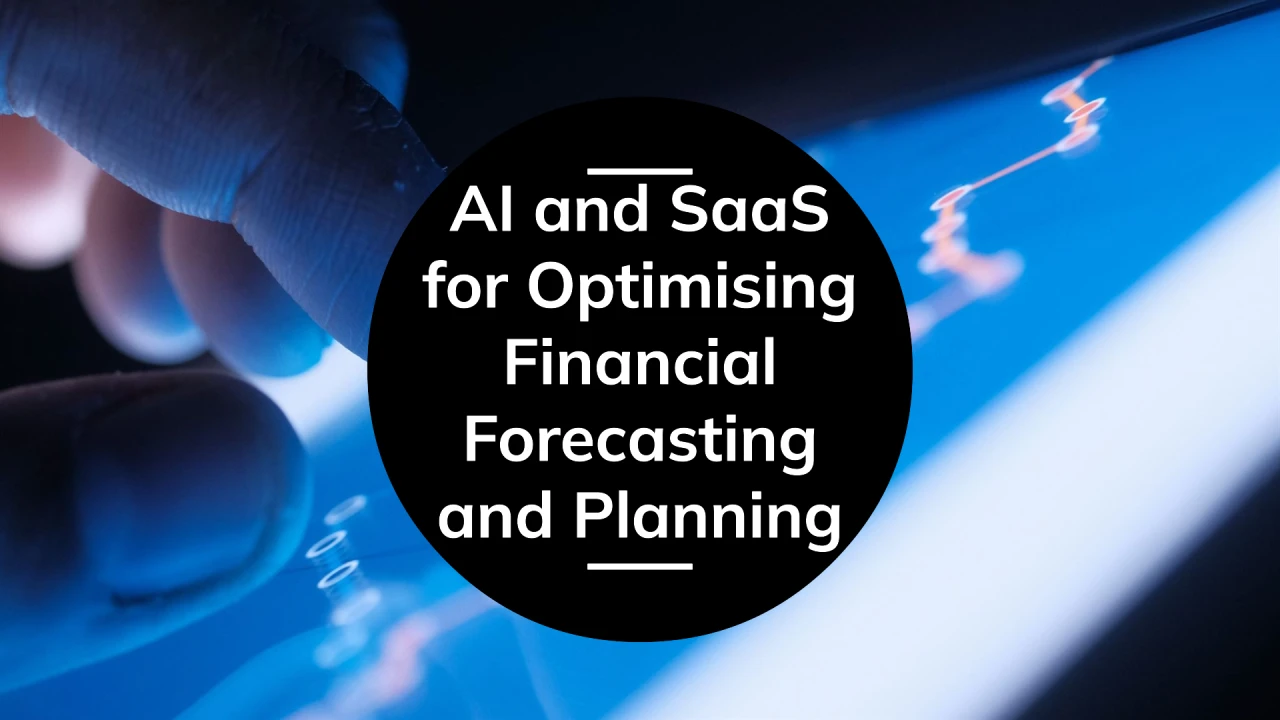AI Driven Financial Forecasting for Businesses
Gain accurate financial insights and make informed decisions with AI-powered forecasting tools.

AI Driven Financial Forecasting for Businesses
The Power of AI in Financial Forecasting
Hey there, business owners and finance pros! Ever feel like you're constantly playing catch-up with your financial predictions? Traditional forecasting methods, while tried and true, often struggle to keep pace with the rapid changes in today's market. That's where AI-driven financial forecasting swoops in to save the day. We're talking about leveraging artificial intelligence to analyze vast amounts of data, identify complex patterns, and predict future financial outcomes with a level of accuracy that manual methods simply can't match. This isn't just about fancy algorithms; it's about giving you a crystal ball for your business's financial future, helping you make smarter, faster decisions.
Think about it: AI can process historical sales data, economic indicators, social media trends, even weather patterns, and find correlations that a human might miss. This holistic view allows for more robust and reliable forecasts, whether you're predicting revenue, cash flow, or even potential risks. It's like having a super-smart financial analyst working 24/7, constantly crunching numbers and spotting trends before they become obvious.
Why AI is a Game Changer for Financial Predictions
So, why should you care about AI in your financial forecasting? Well, for starters, it significantly boosts accuracy. AI models can learn from past errors and continuously refine their predictions, leading to more precise financial outlooks. This means less guesswork and more confidence in your strategic planning.
Secondly, it's all about efficiency. Imagine the hours your team spends manually compiling data and building spreadsheets. AI automates much of this tedious work, freeing up your finance department to focus on higher-value tasks like strategic analysis and scenario planning. This isn't about replacing people; it's about empowering them with better tools.
Thirdly, AI offers unparalleled speed. In a fast-paced business environment, waiting weeks for a comprehensive financial forecast can mean missed opportunities. AI can generate forecasts in minutes or hours, allowing you to react quickly to market shifts and make timely adjustments to your business strategy.
Finally, AI brings a new level of depth to your analysis. It can uncover hidden insights and subtle correlations that are invisible to the human eye. This deeper understanding of your financial drivers can lead to innovative strategies and a significant competitive advantage.
Key Use Cases for AI in Financial Forecasting
AI-powered financial forecasting isn't just a theoretical concept; it's being applied in real-world scenarios across various industries. Let's dive into some practical use cases:
Revenue Forecasting with AI Precision
Predicting future revenue is crucial for any business. AI models can analyze historical sales data, marketing campaign performance, website traffic, customer demographics, and even external factors like economic growth or competitor activity. By identifying complex relationships between these variables, AI can generate highly accurate revenue forecasts, helping you set realistic sales targets, allocate resources effectively, and plan for future growth. For example, an e-commerce business might use AI to predict sales spikes during holiday seasons based on past trends and current marketing spend, allowing them to optimize inventory and staffing.
Cash Flow Management and AI Insights
Cash flow is the lifeblood of any business. AI can predict incoming and outgoing cash flows with remarkable accuracy, helping you avoid liquidity crises and optimize working capital. It can analyze payment terms, customer payment histories, supplier invoices, and even predict late payments. This allows you to proactively manage your cash, ensuring you have enough funds for operations, investments, and debt obligations. Imagine knowing weeks in advance if you'll have a cash surplus or deficit, giving you time to make informed decisions.
Expense Prediction and Cost Optimization with AI
Controlling costs is just as important as generating revenue. AI can analyze historical spending patterns, identify cost drivers, and predict future expenses. This includes everything from operational costs and utility bills to marketing spend and payroll. By accurately predicting expenses, you can identify areas for cost optimization, negotiate better deals with suppliers, and improve your overall profitability. For instance, a manufacturing company could use AI to predict raw material price fluctuations, allowing them to purchase at optimal times.
Risk Assessment and Fraud Detection with AI
Financial forecasting isn't just about predicting positive outcomes; it's also about identifying potential risks. AI can analyze transactional data, identify anomalies, and flag suspicious activities that might indicate fraud or financial irregularities. It can also assess credit risk for potential clients or partners, helping you make informed decisions about who to do business with. This proactive approach to risk management can save your business significant losses.
Inventory Optimization and Demand Forecasting
For businesses dealing with physical products, accurate inventory management is key. AI can analyze historical sales, seasonality, promotional activities, and external factors to predict future demand for specific products. This allows you to optimize inventory levels, reduce carrying costs, minimize stockouts, and improve customer satisfaction. Imagine a retail chain using AI to predict which sizes and colors of clothing will be most popular in different regions, ensuring they have the right stock in the right place at the right time.
Top AI Powered Financial Forecasting Tools and Platforms
Alright, let's get down to some specifics. While many enterprise-level solutions exist, here are a few popular and accessible AI-powered financial forecasting tools that businesses of various sizes can consider. Remember, pricing can vary based on features, usage, and subscription models, so always check their official websites for the most up-to-date information.
Anaplan for Comprehensive Financial Planning
Anaplan is a powerful cloud-native platform that offers connected planning capabilities, including robust financial forecasting. While not exclusively an AI tool, it heavily leverages AI and machine learning for predictive analytics, scenario modeling, and demand forecasting. It's designed for larger enterprises but offers incredible flexibility.
- Key Features: Advanced scenario planning, what-if analysis, predictive analytics, real-time collaboration, integration with various data sources (ERP, CRM, etc.).
- Use Cases: Strategic financial planning, budgeting, forecasting, sales and operations planning (S&OP), workforce planning.
- Comparison: Anaplan is more of a comprehensive planning platform than a standalone forecasting tool. It's highly customizable and scalable, making it suitable for complex organizational structures and diverse data needs. It requires a significant investment in setup and training but offers unparalleled depth for large organizations.
- Pricing: Enterprise-level pricing, typically custom quotes based on user count, modules, and data volume. Expect a significant investment, often in the tens of thousands to hundreds of thousands of dollars annually.
SAP Analytics Cloud for Integrated Business Intelligence
SAP Analytics Cloud (SAC) combines business intelligence, planning, and predictive analytics in one cloud solution. It uses machine learning algorithms for forecasting, anomaly detection, and smart insights, making it a strong contender for businesses already within the SAP ecosystem or looking for an integrated solution.
- Key Features: Predictive planning, smart insights, natural language processing (NLP) for data exploration, integration with SAP and non-SAP data sources, interactive dashboards.
- Use Cases: Financial planning and analysis (FP&A), sales forecasting, operational planning, HR analytics, supply chain optimization.
- Comparison: SAC offers a strong integration with other SAP products, which is a huge plus for existing SAP users. Its predictive capabilities are robust, and the user interface is generally intuitive. It's a good balance between comprehensive planning and dedicated predictive features.
- Pricing: Subscription-based, with different tiers. Starts from around $20-$30 per user per month for basic analytics, but predictive planning features will be higher, potentially $100+ per user per month for advanced capabilities. Enterprise pricing is custom.
IBM Planning Analytics with Watson for AI-Powered Insights
IBM Planning Analytics, powered by Watson, brings AI capabilities directly into your financial planning and analysis. It leverages IBM's Watson AI to provide predictive forecasting, natural language interaction, and automated insights, making complex data more accessible and actionable.
- Key Features: AI-powered forecasting, natural language query, scenario modeling, self-service planning, integration with Excel, robust data governance.
- Use Cases: Budgeting, forecasting, profitability analysis, sales performance management, operational planning.
- Comparison: IBM Planning Analytics excels in its AI integration, particularly with Watson's natural language capabilities, which can make data exploration more intuitive for non-technical users. It's strong in performance for large datasets and complex models.
- Pricing: Subscription-based, often tiered. Expect pricing to be in the range of $50-$200+ per user per month depending on the features and scale.
DataRobot for Automated Machine Learning
DataRobot is an automated machine learning platform that can be used by finance teams to build and deploy predictive models without extensive data science expertise. While not a dedicated financial forecasting tool, its AutoML capabilities make it highly effective for building custom forecasting models.
- Key Features: Automated machine learning, model deployment, MLOps, feature engineering, model monitoring, explainable AI.
- Use Cases: Revenue forecasting, demand forecasting, credit risk scoring, fraud detection, customer churn prediction.
- Comparison: DataRobot is more of a platform for building custom AI models rather than an out-of-the-box forecasting solution. This offers immense flexibility but requires some internal data science capability or willingness to learn. It's ideal if you have unique forecasting challenges that off-the-shelf tools can't address.
- Pricing: Enterprise-level pricing, typically custom quotes. Can be a significant investment, often starting in the tens of thousands annually, depending on usage and features.
Microsoft Azure Machine Learning for Custom Solutions
For businesses with in-house data science teams or those looking to build highly customized AI solutions, Microsoft Azure Machine Learning provides a comprehensive platform. It offers a wide range of tools and services for building, training, and deploying machine learning models, including those for financial forecasting.
- Key Features: Drag-and-drop designer, Jupyter notebooks, MLOps capabilities, integration with Azure services, scalable compute resources.
- Use Cases: Highly customized revenue forecasting, complex risk modeling, algorithmic trading strategies, advanced demand prediction.
- Comparison: Azure ML is a platform for building, not a ready-made solution. It offers maximum flexibility and scalability but requires significant technical expertise. It's best for companies with specific, complex forecasting needs that off-the-shelf software can't meet.
- Pricing: Pay-as-you-go model based on compute usage, storage, and services consumed. Can range from very affordable for small projects to very expensive for large-scale, continuous operations.
Google Cloud AI Platform for Scalable AI Development
Similar to Azure ML, Google Cloud AI Platform offers a suite of tools for building and deploying machine learning models. It's particularly strong for businesses already using Google Cloud services and those looking for highly scalable and flexible AI development environments.
- Key Features: Vertex AI (unified ML platform), AutoML, pre-trained APIs, MLOps tools, integration with Google Cloud ecosystem.
- Use Cases: Custom financial forecasting models, fraud detection, personalized financial advice systems, market trend analysis.
- Comparison: Google Cloud AI Platform, especially with Vertex AI, provides a powerful and unified environment for ML development. It's highly scalable and integrates well with other Google services. Like Azure ML, it requires technical expertise but offers immense customization.
- Pricing: Pay-as-you-go model based on resource consumption. Similar to Azure ML, costs can vary widely based on usage.
Implementing AI Financial Forecasting Best Practices
So, you're ready to jump into AI financial forecasting? Awesome! But before you dive headfirst, here are some best practices to ensure a smooth and successful implementation:
Start Small and Scale Up Your AI Initiatives
Don't try to overhaul your entire financial forecasting system overnight. Begin with a pilot project, perhaps focusing on a single revenue stream or a specific expense category. This allows you to learn, iterate, and demonstrate value before expanding to more complex areas. A phased approach minimizes risk and builds internal confidence.
Ensure High Quality Data for Accurate AI Models
Garbage in, garbage out. AI models are only as good as the data they're trained on. Invest time and resources in data cleaning, validation, and integration. Ensure your historical financial data is accurate, consistent, and comprehensive. The more reliable your data, the more accurate your AI forecasts will be.
Collaborate Between Finance and Data Science Teams
Successful AI implementation requires a strong partnership between your finance experts and data scientists. Finance professionals bring domain knowledge and understanding of business drivers, while data scientists provide the technical expertise to build and deploy AI models. Foster open communication and collaboration to bridge any knowledge gaps.
Regularly Monitor and Retrain Your AI Models
The business environment is constantly changing, and so should your AI models. Regularly monitor the performance of your forecasting models and retrain them with new data as needed. This ensures they remain accurate and relevant in dynamic market conditions. Think of it like tuning a musical instrument; it needs regular adjustments to stay in tune.
Understand the Limitations of AI Forecasting
While incredibly powerful, AI isn't a magic bullet. It's a tool that augments human intelligence, not replaces it. AI models can sometimes struggle with unprecedented events (like a global pandemic) or highly volatile markets. Always combine AI-generated forecasts with human judgment and expert insights. Use AI to inform your decisions, not to make them for you.
The Future of Financial Decision Making with AI
The integration of AI into financial forecasting is not just a trend; it's a fundamental shift in how businesses approach financial planning and decision-making. As AI technology continues to evolve, we can expect even more sophisticated models that can handle greater complexity, provide deeper insights, and adapt more quickly to changing market conditions. This means finance teams will spend less time on manual data crunching and more time on strategic analysis, scenario planning, and value creation. The future of finance is intelligent, proactive, and driven by the power of AI.
Embracing AI in your financial forecasting isn't just about staying competitive; it's about unlocking new levels of efficiency, accuracy, and strategic foresight. So, are you ready to empower your business with AI-driven financial insights? The journey might seem daunting at first, but the long-term benefits are truly transformative.
:max_bytes(150000):strip_icc()/277019-baked-pork-chops-with-cream-of-mushroom-soup-DDMFS-beauty-4x3-BG-7505-5762b731cf30447d9cbbbbbf387beafa.jpg)






